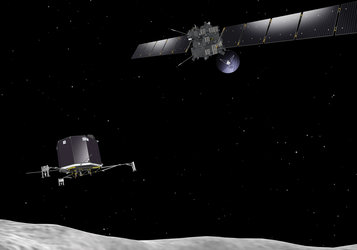

The Philae lander
ilae will take close up and panoramic images of the comet’s surface and will probe and analyse the surface and subsurface to study its structure and composition. A drilling system will take samples from a depth of around 30 cm for detailed analysis. All data will be subsequently relayed to the orbiter, ready for transmission back to Earth.
The lander was provided by a European consortium led by the German Aerospace Centre DLR, the French space agency CNES, and the Italian space agency ASI, together with ESA and institutes from Austria, Finland, France, Hungary, Ireland, Italy and the UK.
APXS, Alpha Proton X-ray Spectrometer
CIVA, Panoramic and Microscopic Imaging System
CONSERT, Radio sounding nucleus tomography
COSAC, Evolved gas analyser – elemental and molecular composition
MODULUS Ptolemy, Evolved gas analyser – isotopic composition
MUPUS, Measurements of surface and subsurface properties
ROLIS, Imaging
ROMAP, Magnetometer and plasma monitor
SD2, Sample Drilling and Distribution
SESAME, Surface electrical, acoustic and dust impact monitoring





